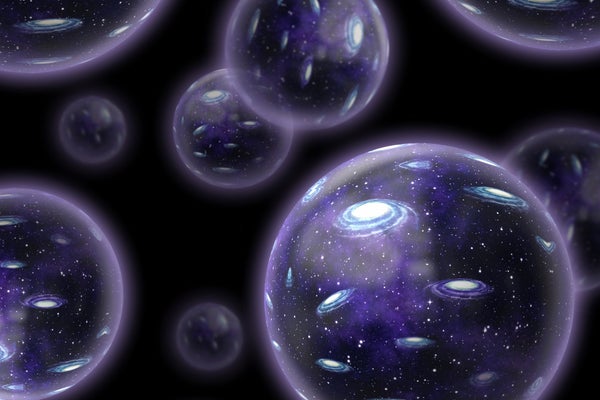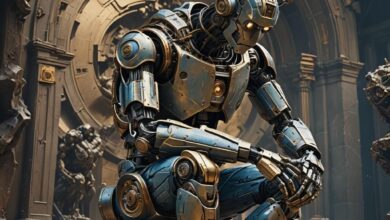AI Could Help Find a Solution for String Theory

AI Could Help Find a Solution for String Theory
String theory could provide a theory of everything for our universe—but it entails 10500 (more than a centillion) possible solutions. AI models could help to find the right one
String theory provides billions upon billions of possible solutions – and each of them describes its own universe. Is there a solution that corresponds to our world?
Tiny little threads whizzing through spacetime and vibrating incessantly: this is roughly how you can imagine the universe, according to string theory. The various vibrations of the threads generate the elementary particles, such as electrons and quarks, and the forces acting among them.
Over the years, however, string theorists have been confronted with increasing difficulties. For the theory to work, additional spatial dimensions are needed, as well as additional particles that have not yet been observed. One of the most serious setbacks, however, is the sheer number of possible solutions that string theory offers: more than 10500 possible universes tumble out of the equations. And among them, you would have to find the one that fits our world, describing the same elementary particles and forces. But it’s not just the enormous number of solutions that causes problems. From a mathematical point of view, it is also extremely difficult to deduce the observable particles and forces from a particular solution. This is why string theorists are now turning to certain artificial intelligence algorithms to help them with the task. In early 2024 researchers achieved impressive results, which they posted on the preprint server arXiv.org.
When physicists worked out string theory in the 1980s, they quickly realized that the mathematical formalism did not fit into four spacetime dimensions. In order for the theory to work, a 10-dimensional spacetime would be required: one dimension of time and nine dimensions of space. Because we only perceive three spatial dimensions in our world, however, the remaining six would have to be rolled up in dimensions that were so tiny that we would not notice any of them. This means that at every point in space there would be a tiny folded-up entity that existed in six dimensions—so small that no microscope could ever resolve it.
On supporting science journalism
If you’re enjoying this article, consider supporting our award-winning journalism by subscribing. By purchasing a subscription you are helping to ensure the future of impactful stories about the discoveries and ideas shaping our world today.
The way in which the six-dimensional space is rolled up plays an important part in string theory. This is because the exact geometry determines how the strings vibrate—and therefore which elementary particles and forces are created. The ultimate aim is to find the six-dimensional geometry of the coiled space that exactly describes our universe. String theorists formulated some requirements that the rolled-up geometries must fulfill but were still confronted with a huge number of possibilities: far more six dimensional geometries than there are particles in the universe.
And then there was another problem: calculating the exact geometric details of the rolled-up dimensions turned out to be a mammoth task. Describing complicated six-dimensional shapes with mathematical precision is virtually impossible. And even if you had the solution, you would still have to calculate how the tiny threads interact with the six-dimensional rolled-up space. This is the only way to deduce which particles and forces could arise in the universe described. The experts were at an impasse.
Advances in the field of artificial intelligence caught the attention of some string theorists, as they seemingly have for a large fraction of the Earth’s population. AI could make it possible to perform calculations that were previously out of reach. In particular, the string theorists turned their attention to neural networks: algorithms whose structure is based on the functioning of the neural cortex. These networks process information in several layers of artificial neurons, transforming an input (for example, the rough shape of the rolled-up dimensions) into a corresponding output (their detailed geometry). By training the networks with thousands and thousands of pieces of data, scientists can induce them to eventually uncover patterns that most people miss. And it is precisely this property that string theorists have now exploited.
In 2017 researchers used neural networks to determine the exact geometries of six of the simplest ways to roll up the excess dimensions. Then Andrei Constantin of the University of Oxford led the team that posted a preprint paper in early 2024: The physicists used other neural networks to investigate how strings would interact with different rolled-up geometries and what elementary particles would result. In the end, they were able to derive the masses of three different quarks and thus provide a concrete prediction in their preprint.
The results do not match the quark masses that we observe in our universe, however. This is not surprising: after all, the scientists picked out individual geometries from 10500 possible configurations and tested them. The correct geometry that describes our universe could therefore still be hidden among these 10500 variants. This is why some string theorists are now aiming to first reduce this monstrous number and only then examine the remaining geometries with neural networks.
This article originally appeared in Spektrum der Wissenschaft and was reproduced with permission.



